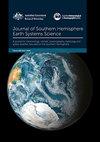Revisions to the Australian tropical cyclone best track database
IF 3.6
4区 地球科学
Q1 Earth and Planetary Sciences
引用次数: 4
Abstract
The Australian tropical cyclone (TC) best track database (BT) maintained by the Bureau of Meteorology has records since 1909 of varying quality and completeness. Since 2005 a series of efforts to improve the database have included: removing internal inconsistencies, adding fixes, and identifying errors using comparisons with other datasets; upgrading intensity information since 1973 including adding maximum winds (Vm) prior to 1984–85, rederiving Dvorak Current Intensity numbers from archived material and accounting for different wind–pressure relationships used; a partial reanalysis of satellite imagery including microwave imagery using the HURSAT dataset since 1987; and considering an objective intensity dataset. The BT homogeneity is reviewed in the context of improvements in satellite technology, observational coverage, scientific developments, BT procedures and the subjective variation between analysts across time and offices. The scale of these variances is greatest in the early stages prior to 1981 in the absence of geostationary satellite imagery until 1978, satellite calibration issues from 1978–80 and prior to the introduction of the enhanced infra-red Dvorak technique in 1981. The current era since 2003 is considered to be the most accurate, comprehensive and homogeneous corresponding to the expansion of the TC database to include the current suite of fields; the application of microwave and scatterometry imagery; greater standardisation of BT practices and slight changes in the application of the Dvorak technique. These improvements have generated a more consistent dataset that could be used for weather and climate research and other TC-related work.修订澳大利亚热带气旋最佳路径数据库
由澳大利亚气象局维护的澳大利亚热带气旋最佳轨迹数据库(BT)有自1909年以来不同质量和完整性的记录。自2005年以来,一系列改进数据库的努力包括:消除内部不一致,添加修复,并通过与其他数据集的比较来识别错误;升级1973年以来的强度信息,包括增加1984-85年之前的最大风(Vm),从存档资料中重新导出Dvorak电流强度,并考虑使用的不同风压关系;使用1987年以来的HURSAT数据集对卫星图像(包括微波图像)进行部分再分析;考虑到一个客观的强度数据集。将根据卫星技术的改进、观测范围、科学发展、电信程序和不同时间和办事处的分析人员的主观差异来审查电信的同质性。这些差异的规模在1981年之前的早期阶段是最大的,因为直到1978年才有地球静止卫星图像,1978 - 80年没有卫星校准问题,在1981年采用增强的红外Dvorak技术之前。自2003年以来的当前时代被认为是最准确、最全面和最均匀的,与TC数据库的扩展相对应,以包括当前的一系列领域;微波和散射测量图像的应用BT实践的更大标准化和Dvorak技术应用的微小变化。这些改进产生了一个更一致的数据集,可用于天气和气候研究以及其他与tc相关的工作。
本文章由计算机程序翻译,如有差异,请以英文原文为准。
求助全文
约1分钟内获得全文
求助全文
来源期刊

Journal of Southern Hemisphere Earth Systems Science
Earth and Planetary Sciences-Oceanography
CiteScore
8.10
自引率
8.30%
发文量
0
审稿时长
>12 weeks
期刊介绍:
The Journal of Southern Hemisphere Earth Systems Science (JSHESS) publishes broad areas of research with a distinct emphasis on the Southern Hemisphere. The scope of the Journal encompasses the study of the mean state, variability and change of the atmosphere, oceans, and land surface, including the cryosphere, from hemispheric to regional scales.
general circulation of the atmosphere and oceans,
climate change and variability ,
climate impacts,
climate modelling ,
past change in the climate system including palaeoclimate variability,
atmospheric dynamics,
synoptic meteorology,
mesoscale meteorology and severe weather,
tropical meteorology,
observation systems,
remote sensing of atmospheric, oceanic and land surface processes,
weather, climate and ocean prediction,
atmospheric and oceanic composition and chemistry,
physical oceanography,
air‐sea interactions,
coastal zone processes,
hydrology,
cryosphere‐atmosphere interactions,
land surface‐atmosphere interactions,
space weather, including impacts and mitigation on technology,
ionospheric, magnetospheric, auroral and space physics,
data assimilation applied to the above subject areas .
Authors are encouraged to contact the Editor for specific advice on whether the subject matter of a proposed submission is appropriate for the Journal of Southern Hemisphere Earth Systems Science.
 求助内容:
求助内容: 应助结果提醒方式:
应助结果提醒方式:


